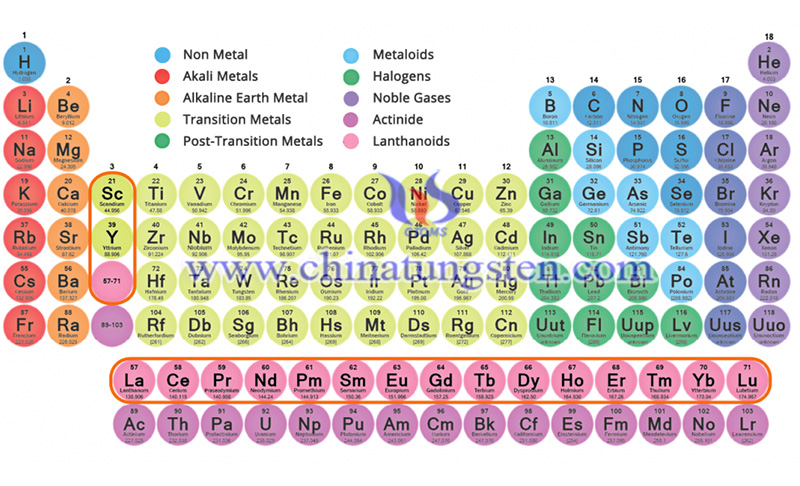About Rare Earth Elements
- Details
- Category: Tungsten's News
- Published on Monday, 13 September 2021 16:51
Rare earth elements occupy 17 spots on the periodic table. They are not "rare" actually as rare earths in sufficiently high concentrations are found all over the world. For the most part, these 17 elements are found together, but some deposits have higher concentrations of certain elements than others. Separating them from the host rock and each other is a multi-step process.
According to the atomic number, rare earth elements are further divided into two categories, namely "light rare earths" and "heavy rare earths". Heavy elements are considered the most valuable. However, there is some debate in the scientific circles as to which elements belong to which category.
As researchers continue to find their uses in everyday products such as smartphones, optical fibers, and medical devices (such as MRI), their importance as the cornerstone of modern technology is evolving.
However, the application driving the current boom in rare earth mining and refining is high-performance magnets made of neodymium (Nd), dysprosium (Dy), samarium (Sm) and sometimes (Ho) holmium. These magnets are needed to supply the growing market for electric motors as well as computer hard drives, precision guided munitions, and wind turbines.

The following is a list of 17 elements and some of their uses in modern technology.
Scandium
It has been discovered in abundance, but the low global production level limits the development of its applications. Uses: dental laser; solid oxide fuel cell; aluminum alloy for baseball bats; bicycle racks; gun barrels.
Yttrium
Its application caused red to appear in TV sets in the 1960s. Yttrium was also found in lunar rocks collected by Apollo astronauts. Uses: Superconducting materials; cancer treatment; lithium-ion batteries; spark plugs; camera lenses.
Lanthanum
The application usually overlaps with cerium. Uses: NiMH batteries; petroleum refining; automotive catalytic converters.
Cerium
The most abundant rare earth. Uses: glass decolorization and polishing; arc lamp; manufacture of aluminum alloy.
Praseodymium
Used to impart yellow/green characteristics to ceramics and glass. Uses: Combined with nickel to make aero-engine alloys; nickel-hydrogen batteries; optical fiber amplifiers; magnets.
Neodymium
Neodymium magnets are favored by the industry because of their high strength and low production cost. Other uses: welder's goggles; tanning booths; purple, burgundy and gray stained glass.
Promethium
A "non-commercial" rare earth element. Rare in nature; mainly produced in laboratories. Uses: Atomic batteries in pacemakers; missiles; radios.
Samarium
One of the elements of high-density magnets. Uses: Samarium-cobalt battery that can withstand extremely high temperatures.
Europium
Named after the European continent. Uses: red in TV sets; may be used in quantum computing chips.
Gadolinium
An element that has few large-scale applications but many small applications. Uses: nuclear ocean propulsion; nuclear shielding; X-ray machine; fuel cell; enhanced MRI images to detect small tumors.
Terbium
A plastic and malleable element. Uses: fuel cell; alloy; flat panel speaker; naval sonar.
Dysprosium
A silvery luster element is also in demand to make high-performance magnets. Other uses: neutron absorption control rods in nuclear reactors; hard disk drives; lasers.
Holmium
Has the highest magnetic strength of any element. Uses: artificially generated magnetic field; neutron absorption regulation nuclear reactor (combustible poison); may be used in quantum computers.
Erbium
A fluorescent pink element is also found in human bones. Uses: Medical laser; malleable alloy; neutron absorption control rod; increase the speed of large-capacity optical fiber lines.
Thulium
One of the least abundant rare earths. Uses: Portable X-ray machine; solid-state military and medical lasers.
Ytterbium
Found that the number is small and difficult to refine. Uses: atomic clock; laser for quantum computing; strengthening steel.
Lutetium
Known as the rarest and most expensive rare earth refining. Uses: Used in the manufacture of jet fuel and diesel fuel refinery catalysts; treatment of gastric cancer, pancreatic cancer and intestinal cancer.
The above is an introduction to the rare earth elements.
- Rare Earth Manufacturer & Supplier, Chinatungsten Online: www.chinatungsten.com
- Tungsten News & Prices of China Tungsten Industry Association: www.ctia.com.cn
- Molybdenum News & Price: news.molybdenum.com.cn
- Tel.: 86 592 5129696; Fax: 86 592 5129797; Email: sales@chinatungsten.com



 sales@chinatungsten.com
sales@chinatungsten.com